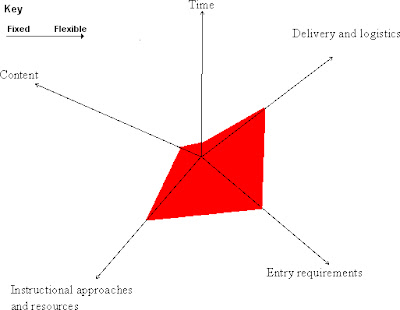Activity Three: Investigate and describe two examples of flexible teaching and learning
Example one: Certificate in Electrical Technology (Level 4)
Who are the students?
The students are typically male with a small percentage of female students (approx 80/20 split). All students come from mixed backgrounds (social, economic, ethnic and religious). The common interest between all the students is that they want to gain knowledge and experience in the Electrical trade to gain an apprenticeship and a career in the industry.
How flexible is the course?
Using the flexibility grid my findings are:
Time
- Start and finish times of course – its one year full time – Not flexible.
- Submitting assignments and interacting with course, Tempo and moments of assessment – the course has a large content that has to be studied in order and assessed straight after the unit has been completed to allow the students to understand the content and be able to achieve completion of the course by the end of the year. This also means the pace of the course is medium to high to ensure all unit standards are covered – Not flexible.
Content
- Topics of course, Sequence of the course – As above, because the course material complements the previous and following units that are studied there has to be a ridged sequence and topic material that is followed throughout the year – Not flexible.
- Orientation of the course, Key learning materials – The delivery of the course content is a mixture of theory/practical teaching and material is delivered through various materials that the students are provided access to e.g. books, manuals, PDFs, moodle and videos etc – Medium
- Assessment standards and completion requirements - Because the electrical industry is governed by various laws and standards the material all has to meet these standards to ensure regulations are meet (which is understandable when working in such a dangerous and unforgiving environment) – Not flexible
Entry requirements
- Conditions for participation – Students will receive preference if they have completed 3 years of secondary school education and received good results in mathematics and science. If English language is not their first language they need to have a average score of 5.5 in the IELTS overall band score – Medium.
Instructional approach and resources
- Language – English (see the above entry requirement) – Fixed
- Social organization of learning – The institutional patterns is tutorials and practical workshops all done in groups with one on one time as required (as time allows in the classes).
- Learning resources, moderation and assignments – Because of the industry that the students are being trained for has very strict criteria and standards, this reflects into the units, material, assessments and any learning material have to meet certain standards that are set by governing bodies of the electrical industry – Fixed
Delivery and logistics
- Time and place, location technology – the contact time with the students is set class times and only available in class rooms/workshops that are set up to train/assess the students and as the time frame that the course is delivered in is set the material is delivered in a set format and time to ensure all unit standards are completed by course completion – Fixed
- Methods, technology for obtaining support and types of help available – all material is available after lecture on moodle, but students are strongly advised not to miss lectures and workshops. All information that is required is available in the resources that the students are required and/or recommended to purchase at the start of the course. Lectures do provide extra support and mentoring if required. All Otago polytechnic student services are available to the students – Medium
How I see the course against the Five dimensions of flexibility
 Summary
Summary
This course is structured like any other trades qualification all trades are bound to standards and all the students have to demonstrate that they not only understand the content but also can physically carry out the work that is required in the industry. This will always work against how flexible the course can become and I can only see that lectures in these trade qualifications (like me) need to find new and innovative ways to teach these students that makes the course seem flexible but still abides by all of the required standards.
The key areas that can be manipulated are how the students are provided the material and how we assess them against the standards.
Thank you to Jake and Barry for allowing me to quiz them on their course.
References
Casey &Wilson, C. J. (2005). A practical guide to providing flexible learning in further and higher education. Retrieved from http://www.enhancementthemes.ac.uk/docs/publications/a-practical-guide-to-providing-flexible-learning-in-further-and-higher-education.pdf

Kevin this is an excellent evaluation of the dimensions of flexibility in this course. I agree, industry standards and NZQA requirements can be barriers. However, I think that you do have some room for movement as you have identified but this will require time for the lecturers to explore some different options, and support to find or develop a variety of resources.
ReplyDeleteSimulations and scenario-based or problem-based learning could be of interest. For example in a simulated virtual environment the students could learn and practise skills and techniques in safety. Something similar to how pilots train...but i guess you will need to find either a military patron to fund this or win lotto as these things can potentially be expensive if using lots of 'bells and whistles'.
Alternatively, the costs to get a developer in a virtual world like Open Sim or second Life is relatively cheap...but it would require support to help students create and use an avatar, and to assist the teachers to do the same. What do you think is this an option?
Potentially, you could do anything if you had plenty of time and lots of funds. These are topics we explore in Sustainable education. Whatever you choose it has to suit both students and teachers.